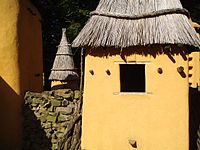
Phnom Penh is the capital and most populous city of Cambodia. It has been the national capital since the French protectorate of Cambodia and has grown to become the nation's primate city and its economic, industrial, and cultural centre. Before Phnom Penh became capital city, Oudong was the capital of the country.

Ho Chi Minh City, commonly known as Saigon, is the most populous city in Vietnam, with a population of around 10 million in 2023. The city's geography is defined by rivers and canals, of which the eponymously-named Saigon River is the largest. As a municipality, Ho Chi Minh City consists of 16 urban districts, five rural districts, and one municipal city (sub-city). As the largest financial centre in Vietnam, Ho Chi Minh City has the highest gross regional domestic product out of all Vietnam provinces and municipalities, contributing around a quarter of the country's total GDP. Ho Chi Minh City's metropolitan area is ASEAN's 6th largest economy, also the biggest outside an ASEAN country capital.

Ernest Hébrard (1875–1933) was a French architect, archaeologist and urban planner, best known for his urban plan for the center of Thessaloniki, Greece, after the great fire of 1917.

The Banque de l'Indochine, originally Banque de l'Indo-Chine, was a bank created in 1875 in Paris to finance French colonial development in Asia. As a bank of issue in Indochina until 1952, with many features of a central bank, it played a major role in the financial history of French Indochina, French India, New Caledonia, French Polynesia, and Djibouti, as well as French-backed ventures in China and Siam. After World War II, it lost its issuance privilege but reinvented itself as an investment bank in France, and developed new ventures in other countries, such as Saudi Arabia and South Africa.
Industrial Bank of Korea is a state-owned bank headquartered in Jung-gu, Seoul, South Korea. Under the Industrial Bank of Korea Act, IBK was established to promote small and medium-sized businesses and improve their economic status by providing an efficient credit system.

Vietnam Railways is the state-owned operator of the railway system in Vietnam. The principal route is the 1,727 km (1,100 mi) single-track North–South Railway line, running between Hanoi and Ho Chi Minh City. This was built at the metre gauge in the 1880s during the French colonial rule. There are also standard gauge lines running from Hanoi to the People’s Republic of China, eventually leading to Beijing, and some mixed gauge in and around Hanoi.
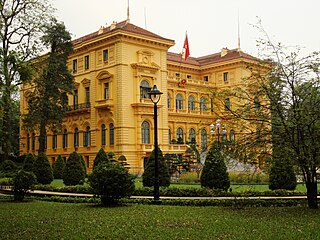
The Presidential Palace of Vietnam, located in the city of Hanoi, currently is the official residence of the president of Vietnam. Before 1954, it was named the Palace of the Governor-General of Indochina .
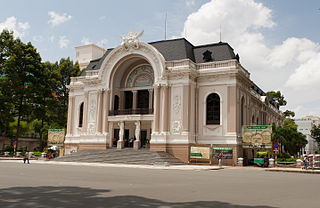
The Municipal Theatre of Ho Chi Minh City, also known as Saigon Opera House, is an opera house in Ho Chi Minh City, Vietnam. It is an example of French Colonial architecture in Vietnam.
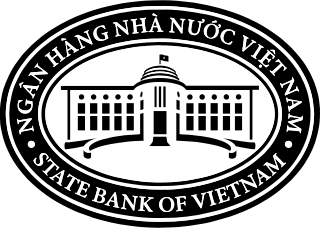
The State Bank of Vietnam is the central bank of Vietnam. It currently holds an about 65% stake of VietinBank, the country's largest listed bank by capital. In 2024, a former State Bank of Vietnam official accused of accepting $5.2 million in bribes faced trial in conjunction with the 2022 arrest of Trương Mỹ Lan and the near failure of Sai Gon Joint Stock Commercial Bank.

National Highway 1 or National Road No.1 (10001) is one of the national highways of Cambodia. With a length of 167.10 km (103.83 mi), it connects the capital of Phnom Penh, through Prey Veng Province, with Bavet, Svay Rieng Province on the border with Vietnam, and continues in Vietnam as the QL22 Highway to Ho Chi Minh City in the south east. In Phnom Penh the road converges with National Highway 2 near Monivong Bridge and National Highway 5 at Stat Chas Circle Garden, near the French Embassy.

Ba Đình is one of the four original urban districts (quận) of Hanoi, the capital city of Vietnam. The district currently has 14 wards, covering a total area of 9.21 square kilometers. As of 2019, there were 221,893 people residing in the district, the population density is 24,000 inhabitants per square kilometer.
Cambodia Angkor Air is the national flag carrier airline of Cambodia, with its corporate headquarters and main hub in Phnom Penh. The company slogan is "Proudly Serve the Kingdom".

Tô Ngọc Vân, also known as Tô Tử, was a Vietnamese painter. Several of his paintings are being displayed at the Vietnam National Museum of Fine Arts. He taught a resistance art class in the northern zone during the war with the French, and died as the result of injuries received at the Battle of Điện Biên Phủ. He was among the first recipients of the Ho Chi Minh Prize in 1996.
The Ho Chi Minh City–Phnom Penh railway is a proposed railway between Ho Chi Minh City, Vietnam and Phnom Penh, Cambodia. The railway is envisioned to complete the missing link on the eastern line of the Kunming–Singapore railway.
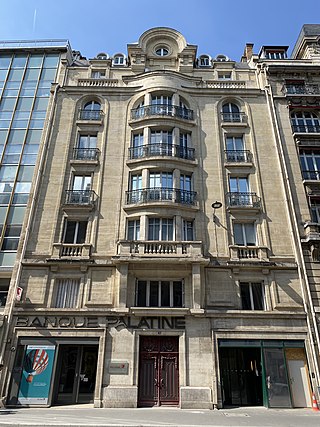
The Franco-Chinese Bank, in French Banque Franco-Chinoise (BFC), full name Banque Franco-Chinoise pour le Commerce et l’Industrie, was a French bank with operations in China and French Indochina, and later in the Indian Ocean and the French West Indies. In 1925 it succeeded the Société française de gérance de la Banque industrielle de Chine, an asset management company that had been formed in October 1922 following the closure of the Banque Industrielle de Chine.
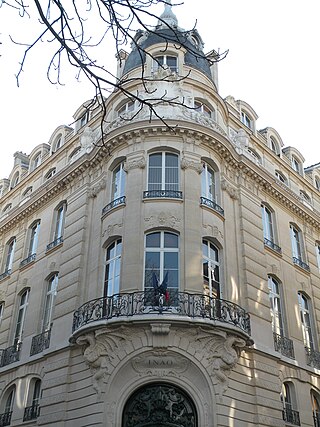
The Société financière française et coloniale was a French investment bank that was an active investor in colonial ventures, particularly in the 1920s. It was founded in 1920 by financier Octave Homberg, who led it until having to leave in stages in 1930-1931 following heavy losses. In 1949, the SFFC changed its name to Société financière pour la France et les pays d'Outre-Mer, which eventually merged into investment company Suez Industrie in 1998.
Louis Chauchon was a 20th-century French architect who had a significant architectural influence in French Indochina, designing several major landmarks, especially: the Central Market in Phnom Penh, which is still in use today, and the Cathedral of Phnom Penh, which did not survive the violence of the Indochina Wars.

















































































